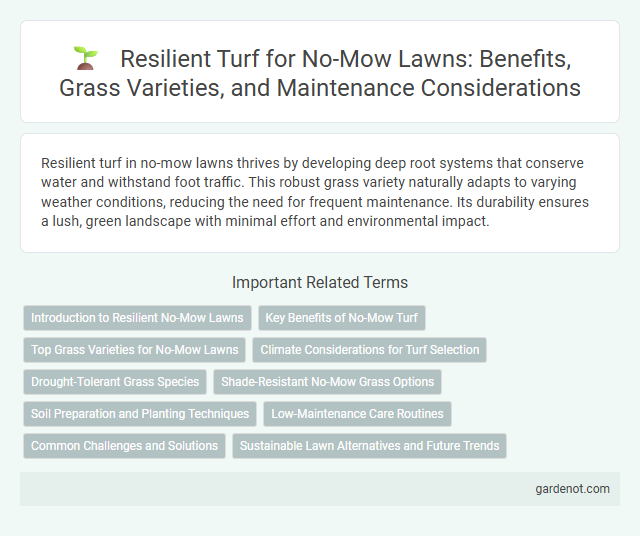Resilient turf in no-mow lawns thrives by developing deep root systems that conserve water and withstand foot traffic. This robust grass variety naturally adapts to varying weather conditions, reducing the need for frequent maintenance. Its durability ensures a lush, green landscape with minimal effort and environmental impact.
Introduction to Resilient No-Mow Lawns
Resilient no-mow lawns utilize drought-tolerant grass species like buffalo grass and fine fescues that require minimal maintenance while maintaining lush greenery. These turf varieties develop deep root systems, enhancing soil health and reducing water consumption by up to 40% compared to traditional lawns. Emphasizing low growth rates and natural density, resilient no-mow lawns provide eco-friendly landscaping solutions suited for sustainable urban and suburban environments.
Key Benefits of No-Mow Turf
No-mow turf features resilient grass varieties that require minimal maintenance, reducing the need for frequent mowing and watering. This sustainable landscaping option promotes deeper root systems, enhancing soil health and drought tolerance. Homeowners benefit from lower utility costs and a more eco-friendly lawn that supports local biodiversity.
Top Grass Varieties for No-Mow Lawns
Fine fescues, including chewings fescue and hard fescue, are top grass varieties renowned for their drought resistance and low maintenance, making them ideal for no-mow lawns. Buffalo grass thrives in warm climates with minimal watering, offering a durable and soft turf that requires little mowing. Native bluegrasses provide a resilient, shade-tolerant option that develops dense, lush lawns without frequent cutting.
Climate Considerations for Turf Selection
Resilient turf varieties such as Bermuda grass and buffalo grass thrive under diverse climate conditions, offering drought tolerance and heat resistance crucial for no-mow lawns. Selecting turf based on local climate patterns, including rainfall frequency and temperature extremes, ensures sustainability and reduces maintenance needs. Climate-adapted turf species help maintain lawn health and appearance with minimal watering and mowing.
Drought-Tolerant Grass Species
Drought-tolerant grass species such as Buffalo grass, Zoysia, and Bermuda grass offer exceptional resilience for no-mow lawns by thriving in low-water conditions while maintaining dense, green coverage. These species possess deep root systems that enhance water retention and reduce irrigation needs, supporting sustainable landscaping practices. Incorporating drought-resistant turf varieties significantly lowers maintenance and conserves water resources in drought-prone regions.
Shade-Resistant No-Mow Grass Options
Shade-resistant no-mow grass varieties such as fine fescues and buffalo grass offer resilient turf solutions for low-maintenance lawns. These grasses tolerate low light conditions while minimizing watering and mowing requirements, promoting sustainability and durability in shaded areas. Choosing shade-adapted no-mow grasses enhances lawn health by preventing patchiness and soil erosion under tree canopies and shaded landscapes.
Soil Preparation and Planting Techniques
Resilient turf thrives with proper soil preparation, including aeration and organic matter incorporation to enhance nutrient retention and drainage. Selecting drought-tolerant grass species and employing no-mow planting techniques like direct seeding or hydroseeding ensure strong root development and minimal maintenance. Optimizing soil pH between 6.0 and 7.0 encourages microbial activity, promoting turf resilience against environmental stresses.
Low-Maintenance Care Routines
Resilient turf varieties designed for no-mow lawns significantly reduce maintenance efforts by requiring minimal watering and infrequent fertilization. These grasses possess deep root systems that enhance drought tolerance and improve soil health, promoting year-round green coverage with less intervention. Implementing low-maintenance care routines for resilient turf not only conserves water but also minimizes the need for mowing equipment and labor.
Common Challenges and Solutions
Resilient turf in no-mow lawns often faces challenges such as drought stress, weed invasion, and soil compaction. Implementing drought-tolerant grass species like fine fescues and improving soil aeration through core aeration techniques enhance turf health and durability. Regular monitoring and incorporation of organic mulches help suppress weeds and maintain optimal moisture levels, promoting a robust no-mow lawn.
Sustainable Lawn Alternatives and Future Trends
Resilient turf varieties such as buffalo grass and fescue are leading sustainable lawn alternatives by requiring less water, minimal mowing, and reduced chemical inputs compared to traditional grass types. These low-maintenance, drought-tolerant species enhance soil health and biodiversity, aligning with future trends in eco-friendly landscaping and urban green spaces. Integration of native, resilient turf blends and smart irrigation technology is expected to redefine sustainable lawn care practices, promoting environmental resilience and resource efficiency.
Resilient turf Infographic

 gardenot.com
gardenot.com